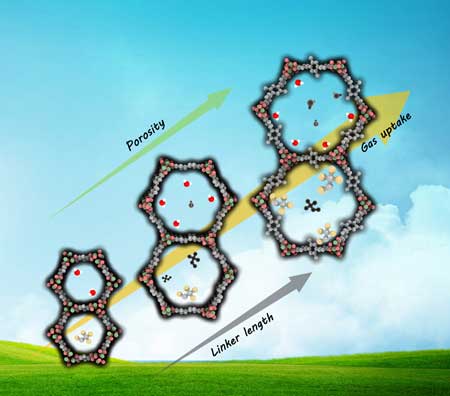| Posted: Jul 28, 2017 |
MOF nanomaterials show promise for chillers
(Nanowerk News) About 15 percent of all energy usage in the U.S. goes toward cooling. New research from the Department of Energy's Pacific Northwest National Laboratory may ultimately help lower energy consumption for air conditioning by engineering tiny porous materials to hold onto a large amount of refrigerant gases.
|
|
The high attachment of this gas – an environmentally friendly fluorocarbon called R134 and water – to nanomaterials called metal organic frameworks hold promise for their use in adsorbent cooling systems that a can be powered by waste heat.
|
 |
| MOFs, sometimes visually likened to the classic Tinkertoy wooden play construction kits, are made up of metal ions clusters connected by organic linker molecules or bridging-ligands whose geometry and connectivity dictate the structure of the MOFs. By adjusting linker geometry and other characteristics, the size, shape and internal surface properties of MOFs can be optimized for targeted specific uses, such as cooling systems.
|
|
In a paper just published in the Journal of the American Chemical Society ("Pore-Engineered Metal–Organic Frameworks with Excellent Adsorption of Water and Fluorocarbon Refrigerant for Cooling Applications"), PNNL found that this refrigerant adhered to the high open metal centers of the Metal–Organic Frameworks (MOF).
|
|
Results also indicate that researchers could likely engineer the pores of the material to enhance the amount of the refrigerant loading even further.
|
|
And the small nanostructure of the MOF and its higher sorption rate means the cooling systems can be made much smaller and, therefore, more efficient and economically viable.
|
|
One exciting development turns out to be the potential to quickly identify refrigerant leaks both in adsorbent chillers and traditional air conditioning systems.The MOF material in the study is highly sensitive to infrared light, which shows even extreme low concentrations of water and refrigerant as a visual peak on a spectrum. This may provide an easy way to detect hidden coolant leaks, which cause a reduction in cooling and a higher use of energy.
|

